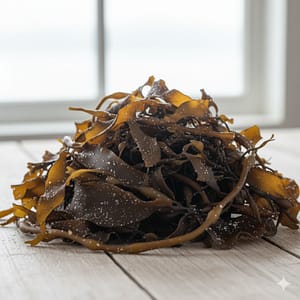- Home
- Kelp Seaweed (Macrocystis pyrifera)

I. General Information
A. Scientific Name:
Macrocystis pyrifera
B. Alternative Names:
Giant kelp, Sea kelp
C. Pronunciation:
Mak-ro-sis-tis py-ri-fer-a
II. Sourcing and Origin
A. Source:
Wild-harvested from giant kelp forests along Pacific coasts of North & South America.
B. Geographic Origin:
Pacific coasts of North and South America, Australia, New Zealand.
C. Method of Processing:
Harvested, dried, and processed into alginates, supplements, and food ingredients.
III. Properties and Uses
A. Physical Properties:
Long, ribbon-like fronds
Can grow over 45 meters long
Golden brown color
B. Chemical Composition:
Alginate polysaccharides
Iodine, potassium, magnesium
Vitamins A, C, E, K
C. Primary Uses:
Skincare: Hydration, anti-aging creams, masks.
Haircare: Nourishing minerals in shampoos and conditioners.
Wellness: Supports thyroid and metabolic health.
Culinary: Used in soups, broths, noodles, and as alginate in food processing.
Household: Fertilizer and animal feed supplements.
D. Key Benefits:
Excellent natural source of iodine
Rich in antioxidants and minerals
Highly sustainable marine resource
IV. Safety and Considerations
A. Potential Allergies:
Iodine sensitivity; may interfere with thyroid medication.
B. Best Practices for Use:
Use in moderation as food or supplement.
C. Special Precautions:
Consult healthcare providers for thyroid-related conditions.
V. Fun & Educational Facts
A. Historical Context:
Has long been used by indigenous coastal communities for food and medicine.
B. Did You Know?
Macrocystis is the fastest-growing seaweed, capable of growing up to 60 cm per day!
C. DIY Recipe Idea:
Kelp noodle salad
Miso soup with kelp
Seaweed broth
